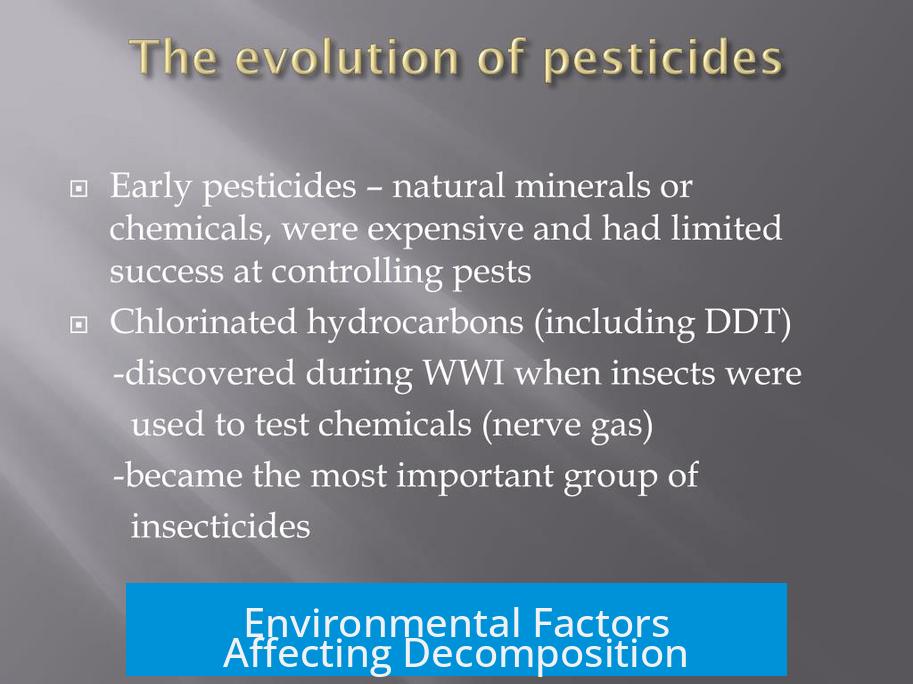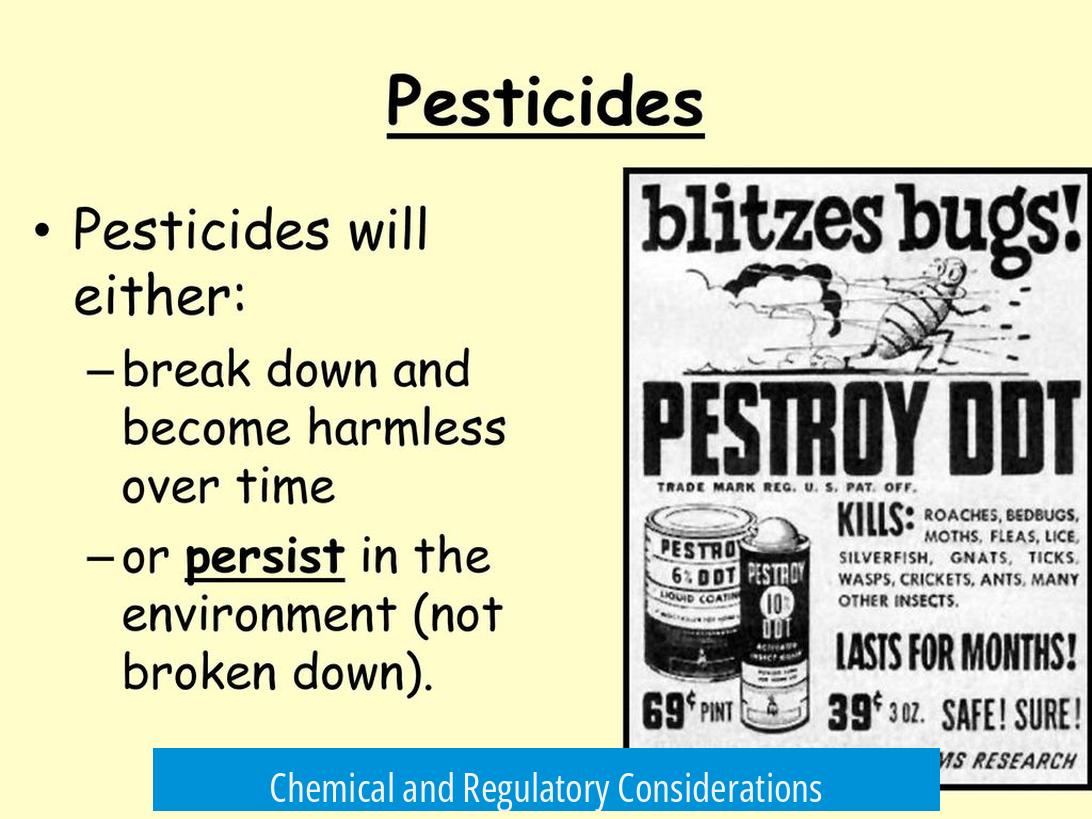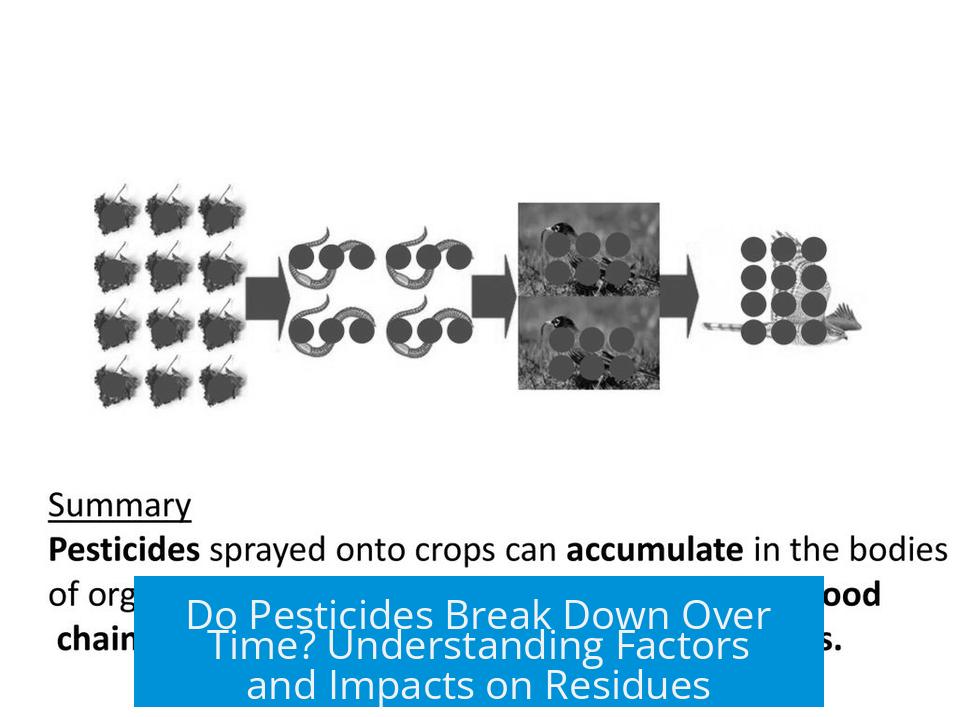Do Pesticides Break Down Over Time? If So, How?

Pesticides do break down over time, but the rate and process depend on their chemical nature and environmental conditions. Newer pesticide formulations generally degrade faster than older ones. The breakdown involves chemical decomposition influenced by several factors.
Variability in Pesticide Breakdown
The chemical structure of a pesticide largely determines how quickly it decomposes. Newer pesticides are often designed to be less persistent in the environment. Conversely, older pesticides, particularly those with stable chemical bonds, may take years or even decades to break down.
Environmental Factors Affecting Decomposition

Pesticides stored indoors in sealed containers degrade very slowly. External factors speed up this process:
- Heat: Higher temperatures increase chemical reaction rates, promoting faster breakdown.
- Ultraviolet (UV) Light: Sunlight’s UV radiation can break chemical bonds in pesticides, aiding decomposition.
- Airflow: Adequate ventilation prevents accumulation and may assist volatilization of some compounds.
Leaving items exposed outdoors during hot sunny days can accelerate pesticide degradation, especially for surface residues.
Practical Tips for Reducing Pesticide Residues
Cleaning items that come into contact with pesticides removes residues effectively. For objects that cannot be washed, extended exposure to sunlight and heat helps reduce contamination, although some materials like upholstery may retain pesticides for long periods despite such efforts.
Chemical and Regulatory Considerations

The physical state of pesticides plays a role in their breakdown. Some rodenticides and pesticides exist as non-volatile solids, which degrade slowly. Others are volatile gases that dissipate quickly. Regulatory agencies like EPA and OSHA control pesticide use and formulation, affecting their environmental persistence and breakdown behavior.
Addressing Misconceptions About Odor and Pesticide Breakdown
Many pesticides, especially rodenticides, are odorless and non-volatile. Detecting a strong smell usually points to other substances such as mold or solvents, not pesticides. This means odor is an unreliable indicator of pesticide presence or degradation status.
Key Takeaways

- Pesticides degrade over time; newer types break down faster than older ones.
- Environmental exposure to heat, sunlight, and air improves pesticide breakdown.
- Cleaning washable items and airing out non-washable ones helps reduce residues.
- Non-volatile pesticides break down slowly; volatile ones dissipate quickly.
- Odors usually do not come from pesticides but from other contaminants.
Do Pesticides Break Down Over Time? If So, How?
Yes, pesticides do break down over time, but how quickly and effectively they do so varies a lot. It depends on what kind of pesticide it is, where it’s stored, and environmental factors like sunlight, heat, and airflow. This might seem straightforward, but the reality is layered and worth unpacking. So, how exactly do these chemicals lose their punch? And what can you do if you want to minimize their presence after use?
Let’s dive into the fascinating world of pesticide breakdown—where chemistry, regulations, and common sense collide.
Not All Pesticides Are Created Equal
First, you’ve got to know that pesticides aren’t just one big group. Their breakdown times can range from a few days to forever. Newer pesticides often break down faster. Why? Because their chemical formulations are designed to be more environmentally friendly and degrade quicker once they’ve done their job. On the flip side, older pesticides might linger around for ages—sometimes years! Imagine a stubborn guest who just refuses to leave your party.
This variability is important because it shapes how long a pesticide stays active—and potentially toxic—in soil, on surfaces, or inside your storage unit. If you want to know how long to worry, you first have to identify which type you’re dealing with.
The Power of Sun, Heat, and Airflow
Picture a pesticide left in a sealed box inside a dark closet. It will likely hang around a long time, quietly refusing to degrade. Now, take that same pesticide outside, expose it to blazing summer heat, sunshine, and a breeze. The game changes immediately. Heat speeds up chemical reactions. Ultraviolet (UV) radiation from the sun breaks down molecules. And airflow helps dissipate volatile compounds.
Because of these factors, leaving things outdoors in the sun is one of the best natural ways to encourage pesticide breakdown. However, this doesn’t mean all pesticides vanish overnight. Some will fade gradually over days or weeks. Others, especially those bound tightly to materials (like upholstery), might stubbornly cling on despite your best outdoor airing efforts.
So, if you’ve got a couch or a carpet treated with pesticides, don’t expect a miracle quick fix. The heat helps, but it’s not a guarantee to completely rid the items of residue.
Practical Tips: How to Reduce Pesticide Residues
If pesticides are a concern, here’s a straightforward plan:
- Wash what you can. Fabrics, clothing, and washable surfaces should be cleaned thoroughly. Use soap and water; this removes a chunk of residues.
- For non-washables, air them out. Put these items outside on a sunny, warm day, ideally for several days.
- Be patient. Some pesticides degrade more slowly; weeks or even months might be needed.
- Know the limits. Large furniture or porous materials may never be truly pesticide-free without professional treatment.
These tips aren’t just handy—they’re grounded in solid science on how pesticide chemistry interacts with the environment.
Understanding Chemical and Regulatory Aspects
Another layer to this story is the chemical form of pesticides and how regulations shape their use. Pesticides can be broadly categorized as either volatile gases or non-volatile solids.
Volatile gases, such as some rodenticides, dissipate quickly into the air. They essentially vanish once exposed. Non-volatile solids, on the other hand, like certain powders and granules, stick around longer because they don’t evaporate easily.
Legal agencies like the EPA, OSHA, and even fire departments strictly regulate which kinds of pesticides can be used, especially in storage facilities. This means that the pesticides you encounter are often carefully chosen for their safety profiles and breakdown characteristics. In other words, you’re not just dealing with chemicals at random—they are selected to balance effectiveness and environmental impact.
Misconceptions About Pesticide Odors and Presence
Here’s a curveball: just because you smell something strong doesn’t mean it’s pesticides. Many pesticides are odorless and non-volatile, meaning they don’t release detectable smells after application.
If you notice a bad smell in an area treated with pesticides, it’s more likely from mold, solvents, or propellants used in sprays. This affects perception but is not a reliable sign that pesticides are still active or breaking down.
This is crucial because many folks worry unnecessarily about lingering pesticide smells when their concerns should be focused on other contaminants that might pose health risks.
What Does This Mean for You?
So, if you ask yourself, “Do pesticides break down over time?” The answer is a clear “Yes, but it depends.” You can see that the type of pesticide, the environmental conditions, and how you handle the treated objects all influence how fast they lose their potency.
**Whether you’re cleaning up after pest control or just curious about long-term pesticide residues, here’s the takeaway:**
- Identify the pesticide type if possible.
- Wash washable items thoroughly.
- Air out non-washables in sunlight and heat as much as practical.
- Don’t rely on odor as an indicator of pesticide presence.
- Understand that some surfaces and materials retain pesticides longer than others.
Bottom line? Breaking down pesticides isn’t magic. It’s chemistry meeting nature’s elements. And with smart handling, you can reduce exposure risks while respecting environmental safety.
Now that you’re armed with these nuggets of knowledge, the next time you spot a pesticide sticker or feel concerned about residues, you’ll know exactly what’s going on—and how to deal with it effectively.
Do all pesticides break down at the same rate?
No, pesticides vary widely in how fast they break down. Newer formulations usually degrade faster, while older ones may persist for a long time in the environment.
What environmental factors affect pesticide breakdown?
Heat, sunlight (especially UV rays), and airflow speed up pesticide breakdown. Pesticides last much longer if kept indoors in a cool, sealed place.
Can washing help remove pesticides from items?
Yes, washing items helps reduce pesticide residues. For things that can’t be washed, leaving them outside in warm weather for several days can lessen contamination, but some items may never be fully pesticide-free.
Do pesticide odors indicate how much residue remains?
Not usually. Many pesticides are odorless and non-volatile. Strong smells often come from mold, solvents, or propellants, not from the pesticides themselves.




Leave a Comment